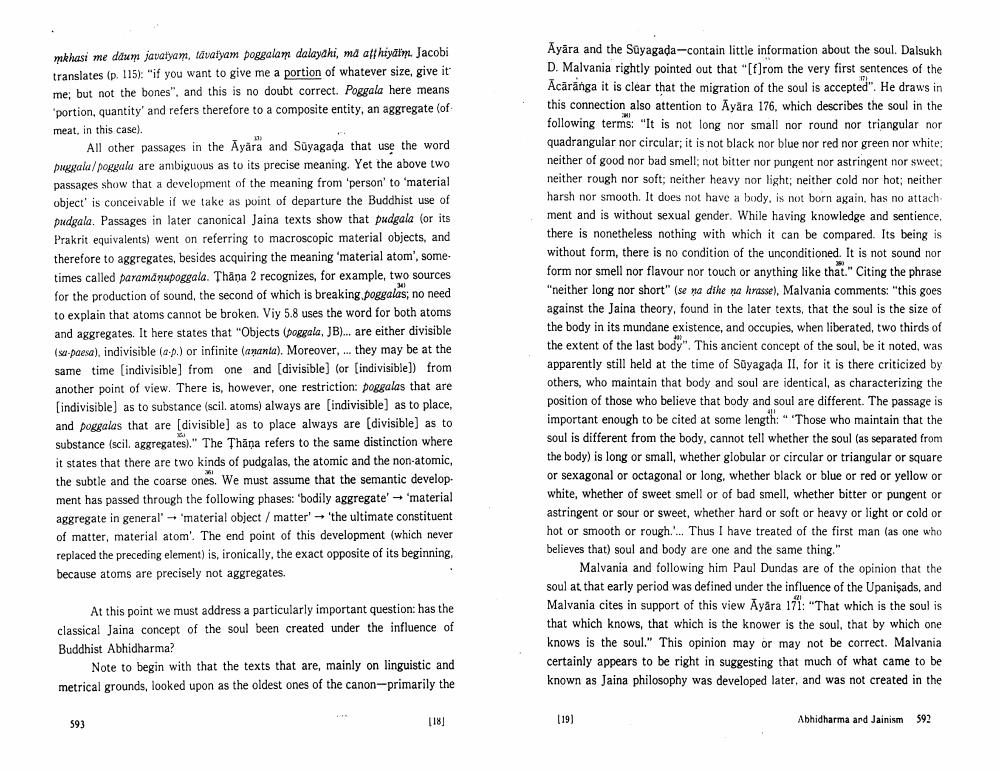________________
mkhasi me dam javalyam, lavatyam poggalam dalaydhi, md affhiydi. Jacobi translates (p. 115): "if you want to give me a portion of whatever size, give it me; but not the bones", and this is no doubt correct. Poggala here means 'portion, quantity' and refers therefore to a composite entity, an aggregate (of meat, in this case)
All other passages in the Ayåra and Suyagada that use the word paggala/poggala are ambiguous as to its precise meaning. Yet the above two passages show that a development of the meaning from person' to 'material object is conceivable if we take as point of departure the Buddhist use of pudgala. Passages in later canonical Jaina texts show that pudgala (or its Prakrit equivalents) went on referring to macroscopic material objects, and therefore to aggregates, besides acquiring the meaning 'material atom', some times called paramanupoggala. Thāna 2 recognizes, for example, two sources for the production of sound, the second of which is breaking poggalas; no need to explain that atoms cannot be broken. Viy 5.8 uses the word for both atoms and aggregates. It here states that "Objects (Doggala, JB... are either divisible (sopaesa), indivisible (a.p.) or infinite (ananta). Moreover, ... they may be at the same time [indivisible] from one and (divisible] (or (indivisible)) from another point of view. There is, however, one restriction: poggalas that are [indivisible) as to substance (scil. atoms) always are (indivisible) as to place, and poggalas that are [divisible) as to place always are (divisible) as to substance (scil. aggregates)." The Thāna refers to the same distinction where it states that there are two kinds of pudgalas, the atomic and the non-atomic, the subtle and the coarse ones. We must assume that the semantic develop ment has passed through the following phases: 'bodily aggregate' - material aggregate in general' - 'material object/matter'-the ultimate constituent of matter, material atom! The end point of this development (which never replaced the preceding element) is, ironically, the exact opposite of its beginning, because atoms are precisely not aggregates.
Ayara and the Suyagada-contain little information about the soul. Dalsukh D. Malvania rightly pointed out that "(from the very first sentences of the Acaränga it is clear that the migration of the soul is accepted". He draws in this connection also attention to Ayara 176, which describes the soul in the following terms: "It is not long nor small nor round nor triangular nor quadrangular nor circular; it is not black nor blue nor red nor green nor white: neither of good nor bad smell, not bitter nor pungent nor astringent nor sweet: neither rough nor soft; neither heavy nor light; neither cold nor hot; neither harsh nor smooth. It does not have a body, is not born again, has no attachment and is without sexual gender. While having knowledge and sentience. there is nonetheless nothing with which it can be compared. Its being is without form, there is no condition of the unconditioned. It is not sound nor form nor smell nor flavour nor touch or anything like that." Citing the phrase "neither long nor short" (se na dthe na krasse), Malvania comments: "this goes against the Jaina theory, found in the later texts, that the soul is the size of the body in its mundane existence, and occupies, when liberated, two thirds of the extent of the last body". This ancient concept of the soul, be it noted, was apparently still held at the time of Süyagada II, for it is there criticized by others, who maintain that body and soul are identical, as characterizing the position of those who believe that body and soul are different. The passage is important enough to be cited at some length: 'Those who maintain that the soul is different from the body, cannot tell whether the soul (as separated from the body) is long or small, whether globular or circular or triangular or square or sexagonal or octagonal or long, whether black or blue or red or yellow or white, whether of sweet smell or of bad smell, whether bitter or pungent or astringent or sour or sweet, whether hard or soft or heavy or light or cold or hot or smooth or rough.... Thus I have treated of the first man (as one who believes that) soul and body are one and the same thing."
Malvania and following him Paul Dundas are of the opinion that the soul at that early period was defined under the influence of the Upanisads, and Malvania cites in support of this view Ayara 171: "That which is the soul is that which knows, that which is the knower is the soul, that by which one knows is the soul." This opinion may or may not be correct. Malvania certainly appears to be right in suggesting that much of what came to be known as Jaina philosophy was developed later, and was not created in the
At this point we must address a particularly important question: has the classical Jaina concept of the soul been created under the influence of Buddhist Abhidharma?
Note to begin with that the texts that are mainly on linguistic and metrical grounds, looked upon as the oldest ones of the canon-primarily the
593
118)
(19)
Abhidharma and Jainism
592




